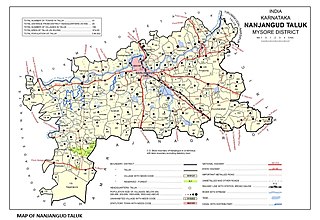
Nanjangud, officially known as Nanjanagudu, is a town in the Mysuru district of Indian state of Karnataka. Nanjangud lies on the banks of the river Kapila, 23 km from the city of Mysore. Nanjangud is famous for the Srikanteshwara Temple located here. Nanjangud is also called Dakshina Kashi. This town is also famous for a type of banana grown in the region called the Nanjanagoodu rasabale. Nanjangud's local administrative unit was designated as a Municipal Committee in 2015 by including Devirammanahalli and Kallahalli village.

Yalahanka is a suburb and Taluk of Bangalore Urban district in the Indian state of Karnataka. One of the zones of BBMP. It is the oldest part of present Municipal Bengaluru (Bangalore) city and the northern end of the city. It is Nadaprabhu Kempegowda I, of the Yelahanka Prabhu clans, who laid the foundation of present-day Bengaluru through the creation of a "mud fort town" in 1537 CE
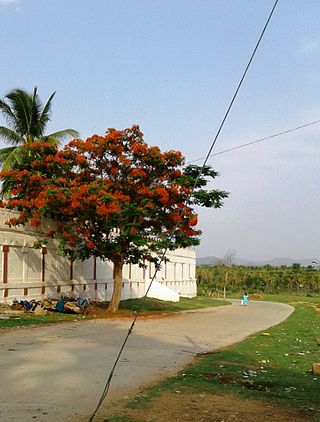
Arsikere is a city and taluka in the Hassan district in the state of Karnataka, India. It is the second largest city in Hassan district, demographically. Arsikere city municipal council consists of 35 wards. This region is known for its coconut production and is also called Kalpataru Nadu. Arsikere Junction is a major railway junction in the South Western Railway which links Mangalore and Mysore to North Karnataka and a central place for tourists who visit nearby places that do not have rail access, such as Belur, Halebidu and Shravanabelagola, Harnahalli, and Kodimata.
Mulabagilu is a town and administrative center of Mulabagilu taluk, in the Kolar district in the state of Karnataka, India. The town is situated on the National Highway 75 and is the easternmost town of the state.
Chikkaballapur is the district headquarters of the newly created Chikkaballapur district in the state of Karnataka, India, which was carved out from Kolar district. It is located within 3 km of Muddenahalli. A $400 million Pharmaceutical SEZ is coming up in Chikkaballapur on 325 acres (1.32 km2), the first of its kind in India. Furthermore, the noted Traveler Bunglow is being converted into a state-of-the-art bus terminus. A new district government headquarters and police headquarters is being constructed at a cost of $5 million. In addition, the state government is releasing over $10 million to develop the city and expand underground sanitary systems. It is a regional transport and educational hub, and is a major site for grape, grain, and silk cultivation"

Tumkur is a city located in the southern part of Indian state of Karnataka. It is situated at a distance of 70 km (43 mi) northwest of Bangalore, the state's largest city and capital, along NH 48 and NH 73. It is the headquarters of the Tumakuru district. It is located at an altitude of 835 m (2739.5 ft).
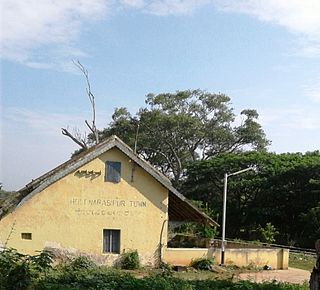
Holenarasipura is a town and taluk in Hassan district of Karnataka. The town is situated on the banks of the Hemavati, one of the tributaries of the Kaveri.

Sadali is a hobli headquarters in Chikballapur district, Karnataka, India. It is located at a distance of about 100 km from Bangalore. It is equidistant from five taluk headquarters: Sidlaghatta, Chintamani, Bagepalli, Gudibanda and Chikballapur.
Pavagada or Pamukonda is a taluk in the Tumkur district in Karnataka, India. Historically it was part of the Mysore kingdom. Though it is geographically connected to Chitradurga district inside state of Karnataka, it comes under Tumkur district. It is 157.8 km from state capital of Bengaluru. Uttara Pinakini river flows into this Taluk. Pavagada Taluk falls on the border of Karnataka, hence a majority of the population are bilingual speaking Kannada and Telugu. The town is famous for its fort located on the hill, Kote Anjaneya temple at the foothills and also the temple of Sri Shani Mahatma.

Chikkaballapura district is a district in the state of Karnataka, India. On 23 August 2007, it was carved out of the pre-existing Kolar district which was the fourth largest district of Karnataka by moving the talukas of Gauribidanur, Gudibanda, Bagepalli, Chikballapur, Manchenahalli, Sidlaghatta and Chintamani into the new district. Kannada is the official language.
Punacha is a village in the southern state of Karnataka, India. It is located in the Bantwal taluk of Dakshina Kannada district in Karnataka.
Manchenahalli is a town in the southern state of Karnataka, India. On 31 October 2019, the chief minister of Karnataka state, Shree B S Yediyurappa promoted Manchenahalli as Taluk. It is located in the Gauribidanur taluk of Chikkaballapur district in Karnataka. It is located 14 km from the town of Gowribidanur and 10 km from Muddenahalli-Kanivenarayanapura. The town houses a Jain shrine called Manchenahalli Jain Temple devoted to Shri Kodi Brahmadeva, Also a dam is attached to this temple. A tourist hub is located in nearby Minikanagurki. Also it's near to Srinivasagara
Kuruburu is a village in Chintamani Taluk in the Chikballapur district in the state of Karnataka, India.
Dharmavarahalli is a village in Chintamani Taluk of Chikkaballapura district, Karnataka. It is located at a distance of 30 km from Chintamani town, and is situated on the banks of Paapagni River which originates in the famed Nandi Hills. Though not very popular yet, its dwellers are gradually working to bring prominence to it.
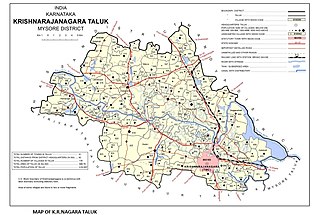
Saligrama is a new sub-district of Mysore district, situated on the northern bank of the river Cauvery [Kaveri]. This place is esteemed as sacred by the Shri Vaishnavas on account of its having been the residence of Sri Ramanujacharya. It is the headquarters of Saligrama Taluk. It was established as a new taluk carving out of K.R.Nagar taluk with effect from 31.12.2020 and become ninth taluk of Mysore district of Karnataka, India.
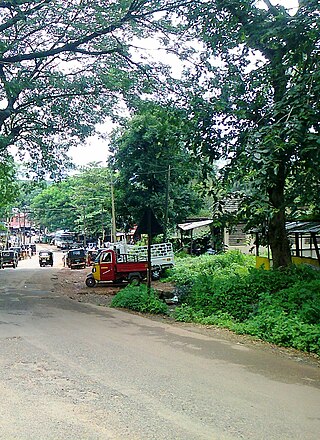
Vellarikund is a town and taluk headquarters in the Hill range of Kasaragod District in the state of Kerala. Vellarikundu is located between Odayanchal and Chittarikkal on Odayanchal-Cherupuzha Road.

Panathur is a major town in Vellarikundu Taluk of Kasaragod district in Kerala State, India. It belongs to Kanhangad legislative constituency. Its population is about 12,000. It lies 1 km away from Kerala - Karnataka border, 42 km away from the nearest municipality, Kanhangad and 53 km away from the district headquarters, Kasaragod. It is surrounded from three sides by forest reserves and cashew plantations. Kudumbur River flows adjacent to the town.

Bengaluru North University (BNU) is a state university located in Tamaka, near NH 75 in Kolar, Karnataka, India. The university was established in 2017 by the Government of Karnataka through the Karnataka State Universities (Amendment) Act, 2015 trifurcating Bangalore University by creating Bengaluru North University and Bengaluru Central University.
Handiganala is a village in Sidlaghatta Taluk in Chikballapur District of Karnataka State, India It is located 15 km towards East from District headquarters Chikballapur 2 km from Sidlaghatta 62 km from State capital Bangalore Mallur, Ablodu, Devaramallur, Bannikuppe, Cheemangala are the nearby Villages to Handiganala.
















